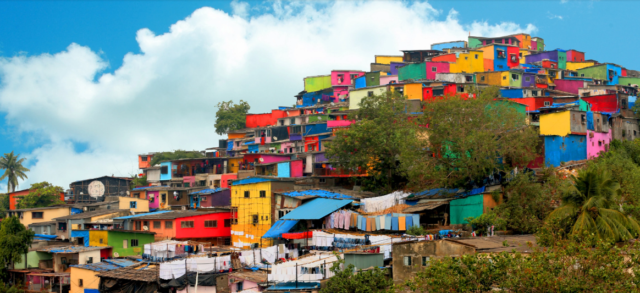Terence Ferreira quit his advertising job to go on a painting mission that will make Mumbai slums beautiful once again!


Twenty-three year-old Terence Ferreira is the co-founder of Chal Rang De – a non-profit organization on a mission to make Bombay gorgeous again. Terence used to work in the strategy team of an advertising agency before he realized that being an artist was his true calling. He quit his job 5 months ago to pursue his passion and dedicate all his time and efforts to Chal Rang De.
In conversation with Terence Ferreira:
How did the idea of Chal Rang De originate?
I met Dedeepya Reddy, the co-founder of Chal Rang De, at my previous workplace. Dedeepya Reddy runs a creative agency in Mumbai where I worked as a business development associate. Ms. Reddy was travelling on the Mumbai metro one fine day when she saw the slums at Asalpha station (Mumbai suburbs). She viewed those slums as a canvas to do something. During one of our conversations, we were discussing our hobbies and I told her that I am an artist by passion. We went to Asalpha a few days after that. But, we had no idea what we wanted to do. Our only vision was that we wanted the place to look beautiful.
Why did you establish Chal Rang De?
We aim to transform the city into a colorful amalgam of local stories and talent. By painting walls with vibrant colors, we believe in changing people’s perspective on Mumbai slums and creating positive emotions among residents.
How did your pilot project at Asalpha take off?
We visited Asalpha, spoke to the people out there and took lots of pictures. Initially, the people out there were scared of us. Most of them shut their doors in our faces. They thought we were BMC officials and were there to take their homes. Our first step was to mend the gap and let them know our intentions. The first time around, we just had words. We told them what we had in mind and why we wanted to do it. They weren’t ready to believe it because they come across a lot of people who make empty promises, never to show their face again.
We clicked pictures, came back to our office, created digital renditions and we went again with all the material in hand. When we showed them the pictures, they couldn’t believe their eyes. That’s how our pilot project kick-started.


Asalpha is massive. How did you manage to pull off a project of this magnitude?
It wasn’t easy in the beginning. We had to sort out permissions. For this, we spoke to the people in charge of that area. We also spoke to the people from those 300-500 houses. After that, we approached sponsors like Mumbai Metro. We also spoke with Snowcem Paints. We explained to them how painting as an art has been lost. They supplied us with the necessary materials. But the main question was – who was going to paint? We didn’t have enough funds to hire painters. We put a word out on social media and that’s when the best thing happened! In just 3-4 days, we got 1000 registrations! 300-400 people showed up and we painted 600-700 houses in just 4 days! To this date, 5000+ volunteers have registered with us.
Did you break any stereotypes along the way?
Several! When most people think of slums, they think of dirty and drab places. When in reality, their houses are cleaner than ours!
What inspires you to keep doing this?
Different people value different things. Some value money, while some others give importance to relationships. The volunteers who come to paint for our projects value art. You can see a big smile on each of their faces after they’ve painted. The happiness our volunteers experience inspires us. Also, the joy of the people whose houses we are giving makeovers to, cannot be put into words.


What’s the biggest challenge you’ve faced?
The biggest challenge we faced was acceptability. These people who live in slums are an isolated community. Nobody spares a second thought to them. Initially, they weren’t ready to believe as to why we would do this for them. Once, an aunty in Khar just shooed us away. When we asked her why she was behaving in such a manner, she said that a lot of people come and take her story. But when they put her story on social media, they just talk about her hardships. She believes her life is so much more than just the hardships. She thought we were going to do the same thing. So yes, acceptability remains our biggest challenge to date.
How do you overcome this challenge of lack of acceptability?
When dealing with them, we become the nicest versions of ourselves! We talk to them and over time, they open up to us. We don’t just go to places to paint, we make those people our families. When out there, we eat with them and rest in their houses.
How has Chal Rang De impacted your life?
In the beginning, we thought we were going to beautify the place and move on to the next project. But what we weren’t expecting is the level of humanity that entered our lives. We became more humane.
Did you meet with failure at any stage of your journey?


I wouldn’t call this a failure, but there were several disappointments in the Khar (Mumbai suburb) project. We went a step ahead and did the roofing and waterproofing for them. There were 700 houses in that project and a few people complained as things weren’t going as planned. It was a learning experience for us.
Who/what has been your support?
The artists and painters who volunteered have been our biggest support.
What’s the one incident that will stay with you for life?
At D N Nagar, there was this one man who we met every day. One day, we struck up a conversation. He said his son has a tumor and was in the hospital. The man used to come to visit the gurudwara that was opposite the wall we were painting. He told us that when he saw us painting every day, his problems vanished for a little while. Seeing us paint was like therapy for him.
What are you most proud of?
I’m most proud of the fact that we never underperform. If you see our digital renditions and the actual project, you’ll not find any difference.
Do you have any advice for our readers?
A lot of people want to do a lot of things, but nobody actually does it. My advice would be to stop thinking and start doing!
Found this article interesting? Click here to read how the Robin Hood Army is eradicating hunger in India by feeding the poor!






























